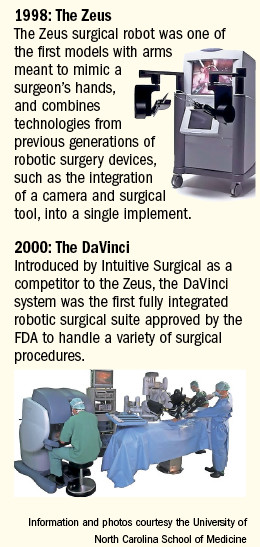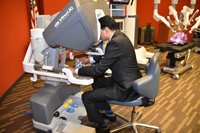South Nassau introduces the latest in robotic medicine
Looking down through the 3D viewfinder, the metal arms extended naturally from my torso. If not for the crab-like claw tips, I could have easily mistaken them for my own. I slipped my thumbs and forefingers through fabric loops located on the machine just below my face. The arms moved almost like a marionette’s.
The mechanical wrists had about the same range of motion as a human’s as I manipulated a series of rubbery test objects with ease. Through haptic (tactile) feedback, I could feel when the robotic arms met resistance. As I observed my work, I was surprised to discover that the arms, which had seemed so like my own, were actually about the size of pencils.
Meet the DaVinci Xi — the latest minimally invasive robotic surgery technology available at South Nassau Communities Hospital. It was delivered to the medical center’s surgery ward this August. The $2 million, four-armed contraption is among the most advanced in medicine, and allows for surgeons to perform operations that, years ago, would have required doctors to crack open a patient’s rib cage or move organs around, to get to the body part that required attention.
“We used to use the traditional method, which was to make a big incision and cut the ribs,” said Dr. Shahriyour Andaz, director of thoracic surgery at South Nassau, “And that was painful. So we changed to minimally invasive techniques, and the robotics platforms offer that.”
“Basically, it provides three-dimensional vision, and it’s intuitive,” Andaz continued. “If you want to move your hands to the right, the arms move to the right. It’s almost like having tiny hands in the chest cavity.”
The Xi is the newest robotic surgery device in use at South Nassau, where doctors have been using DaVinci systems for the past eight years, according to Dr. Rajiv Datta, chairman of surgery at South Nassau. Previous systems, while helpful, had drawbacks, he said, such as poor ergonomics and a lack of versatility. He likened the advances in robotic surgery systems to the way cell phones add new features with each new model.
“The Xi does additional things better than previous generations,” he explained, “so just the way phones advance, this has advanced where the docking and set-up is much easier, operating in different body cavities is much easier, changing the angle of the robot is much easier.”
He added that the Xi allows for two surgeons to operate on a patient simultaneously, and features built-in training infrastructure, giving surgeons the opportunity to become better acquainted with the system before use on a patient.
Datta noted that robotic systems such as the DaVinci do not make new surgical procedures possible, but instead allow for greater efficiency when performing existing techniques.
“Technically, it’s doing all [the] surgeries we were doing before,” he said, “with the advantage of really tiny incisions.” The minimally invasive nature of robotic surgeries, he said, allow for quicker healing and lower the risk of complications, such as infection.
He said he has embraced the technology in his department because before, minimally invasive surgeries had to be performed with rigid tubes inserted into the patient through devices called laparoscopes. “There were two issues with that,” he said. “One: The vision was two dimensional and the second was ergonomics, we had to look up and operate down. But now, we can look down and operate down. It’s more natural.”
After finishing with the Xi’s demonstration model, I picked my head up from the viewfinder and took my hands off of the controls. The machine locked into place with a click, unable to move without a user at the helm. The marionette had been placed back on the shelf.











